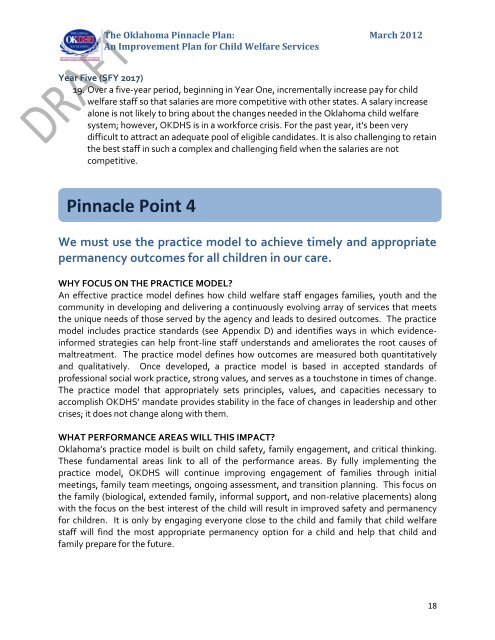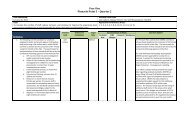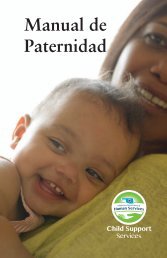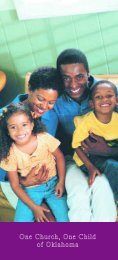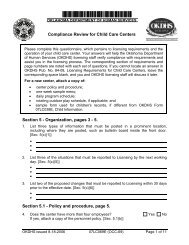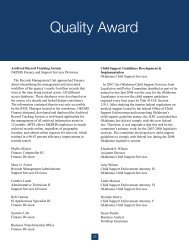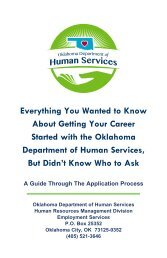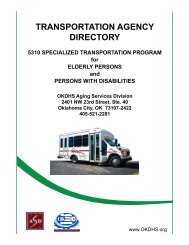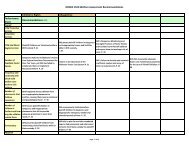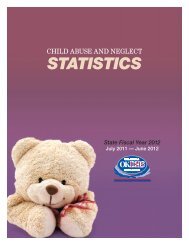The Oklahoma Pinnacle Plan - Oklahoma Department of Human ...
The Oklahoma Pinnacle Plan - Oklahoma Department of Human ...
The Oklahoma Pinnacle Plan - Oklahoma Department of Human ...
Create successful ePaper yourself
Turn your PDF publications into a flip-book with our unique Google optimized e-Paper software.
<strong>The</strong> <strong>Oklahoma</strong> <strong>Pinnacle</strong> <strong>Plan</strong>:<br />
An Improvement <strong>Plan</strong> for Child Welfare Services<br />
March 2012<br />
Year Five (SFY 2017)<br />
19. Over a five-year period, beginning in Year One, incrementally increase pay for child<br />
welfare staff so that salaries are more competitive with other states. A salary increase<br />
alone is not likely to bring about the changes needed in the <strong>Oklahoma</strong> child welfare<br />
system; however, OKDHS is in a workforce crisis. For the past year, it's been very<br />
difficult to attract an adequate pool <strong>of</strong> eligible candidates. It is also challenging to retain<br />
the best staff in such a complex and challenging field when the salaries are not<br />
competitive.<br />
<strong>Pinnacle</strong> Point 4<br />
We must use the practice model to achieve timely and appropriate<br />
permanency outcomes for all children in our care.<br />
WHY FOCUS ON THE PRACTICE MODEL?<br />
An effective practice model defines how child welfare staff engages families, youth and the<br />
community in developing and delivering a continuously evolving array <strong>of</strong> services that meets<br />
the unique needs <strong>of</strong> those served by the agency and leads to desired outcomes. <strong>The</strong> practice<br />
model includes practice standards (see Appendix D) and identifies ways in which evidenceinformed<br />
strategies can help front-line staff understands and ameliorates the root causes <strong>of</strong><br />
maltreatment. <strong>The</strong> practice model defines how outcomes are measured both quantitatively<br />
and qualitatively. Once developed, a practice model is based in accepted standards <strong>of</strong><br />
pr<strong>of</strong>essional social work practice, strong values, and serves as a touchstone in times <strong>of</strong> change.<br />
<strong>The</strong> practice model that appropriately sets principles, values, and capacities necessary to<br />
accomplish OKDHS’ mandate provides stability in the face <strong>of</strong> changes in leadership and other<br />
crises; it does not change along with them.<br />
WHAT PERFORMANCE AREAS WILL THIS IMPACT?<br />
<strong>Oklahoma</strong>’s practice model is built on child safety, family engagement, and critical thinking.<br />
<strong>The</strong>se fundamental areas link to all <strong>of</strong> the performance areas. By fully implementing the<br />
practice model, OKDHS will continue improving engagement <strong>of</strong> families through initial<br />
meetings, family team meetings, ongoing assessment, and transition planning. This focus on<br />
the family (biological, extended family, informal support, and non-relative placements) along<br />
with the focus on the best interest <strong>of</strong> the child will result in improved safety and permanency<br />
for children. It is only by engaging everyone close to the child and family that child welfare<br />
staff will find the most appropriate permanency option for a child and help that child and<br />
family prepare for the future.<br />
18


